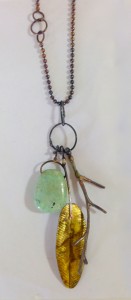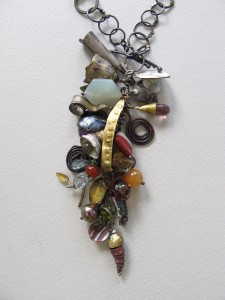
One of Micki Lippe’s production line necklaces. Photo courtesy Micki Lippe.
Artists make jewelry because they love the creativity, they love working with their hands, and the love the joy they give those who wear it. However, if artists make jewelry as a business, they want to make a living doing it. Time and the economy have taught many artists that production work may be the only way to survive and continue to do the work they love.
Making an affordable production line has many benefits. It introduces new jewelry artists to an audience. It gives buyers a way to get to know you, your design style, and the quality of your work. It gives those who cannot afford one of your pricier pieces, a way to begin collecting your work. As those customers grow in affluence, they may come to you for more lucrative custom pieces. Production also gives you a wider audience than you might reach with one-of-a-kind pieces. The more people who wear your jewelry, the more potential buyers see it.
While the thought of going into production may be overwhelming, a production line can be built around the time you have available to make the work, the money you have to invest, the materials you have available, the skills you command, and the direction in which you want to grow your business, all while allowing you to earn the money to make a living and grow that business.
A production line does not have to be devoid of creativity, artistry or originality. Although “all the sexiness is in one-of-a-kind pieces,” says Vermont jewelry artist Karen Krieger, “it is more challenging trying to come up with something that you can put into the marketplace that has a stamp of individuality at a price people are willing to pay.”
Consider it a test of your ingenuity.
What is a production line?
Production lines are made up of multiples: dozens of identical or nearly identical earring pairs, pendants or brooches that can be reproduced relatively easily. Often such lines are limited editions—pieces are reproduced by the dozen or the hundreds and then retired, never to be produced again, at least not without modification. Other lines may be produced in the thousands for an outlet such as a lifestyle catalog, or simply produced for as long as the demand stays strong.
While unique, one-of-a-kind pieces are usually targeted toward a smaller, usually higher-end client, most production pieces need to appeal to a broader, usually less affluent audience. Production pieces are most often created as impulse purchases, and are usually priced accordingly.

One-of-a-kind pieces often share similar roots with production line work. Photo courtesy Micki Lippe.
Most artists create production lines using the same signature techniques and styles they use for their one-of-a-kind pieces. However, this approach means finding ways to reduce the time and materials necessary to make the pieces so that, while still handmade and identifiably the artist’s work, they can be sold at an attractive price point.
